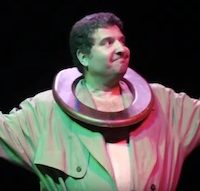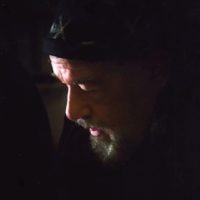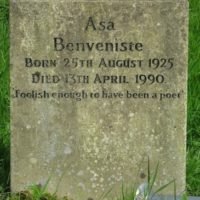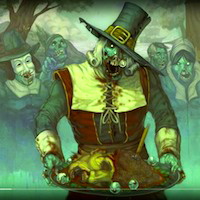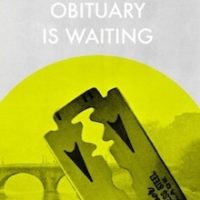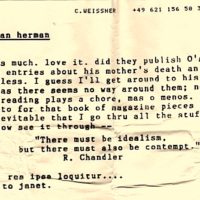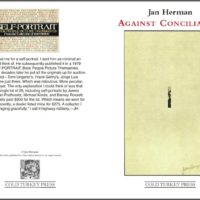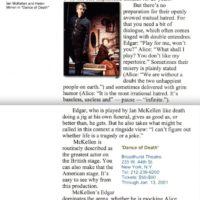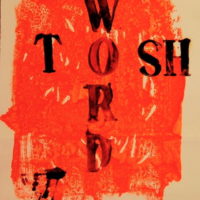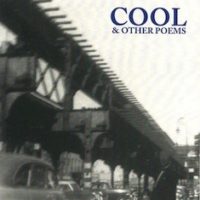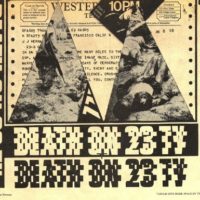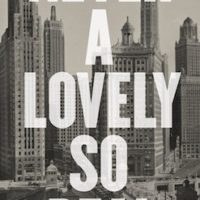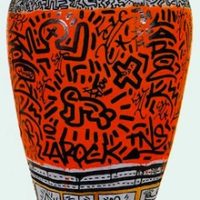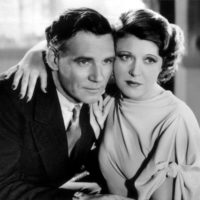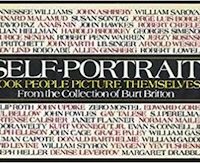It’s unlikely that Sylvia Plath would have picked the graveyard of Heptonstall Church for her last resting place. Early in her marriage to Ted Hughes, she declined the suggestion that they move into some cheap and rambling old manor in the socially depressed Calder Valley where Hughes had spent part of his childhood. Asa Benveniste definitely chose the location of his own grave, having spent the final years of his life in Hebden Bridge, the valley town that adjoins Heptonstall.
David Erdos in His One-Man Show About Lenny Bruce
At the Cockpit Theatre in London: ‘His Last Cabaret’
Plus his poem, ‘When a Tower Falls,’ which carries on Heathcote Williams’s legacy, but in Erdos’s own key: When a society falls, what you notice first is the rubble, / Seen on TV, ghosted buildings give way to dust / Through bomb blast. Through the sudden heat and the haze, / You will see only the print of lost towers, fading with age: / Time’s fragmented, and your first tasted moments / Clash and mix badly with the afterburn and the bitter / Of what could well be your last. Of course, the world has seen / Towers fall through man made event, false god sanctioned, / But we seem to have made no true effort to rebuild or renew / What was lost. What we lack has been leased and sold again / To new builders who continue to falsify all around us / While tapping us still for the cost. …
This Author Has a Beef With Amazon . . .
Richard Kostelanetz has produced many titles in his Archae Editions line of books over the past eight years via Amazon’s print-on-demand publishing service. But a few weeks ago they suddenly disappeared from the Amazon site. He was shocked. When he asked to have them restored, he was informed electronically that they had been removed because they contained pornographic images. He disagreed. Nevertheless, he decided to remove the “objectionable” content. Even as he offered to do so, however, he was further informed that his entire Archae Editions account had been closed—permanently. He would not be allowed to publish in the future any Archae books whatsoever. Period. Full stop. End of story. Fuck you.
‘Foolish Enough to Have Been a Poet’
Asa, translucent Jew,
your eyebrows arched
so high as to hold
nothing excluded that might want in,
it’s proper to come your way
by deflection. Exquisite poet . . .
— Roy Fisher
A Traditional ‘Straight Up’ Thanksgiving
Our Thanksgiving team of the late William S. Burroughs and Norman O. Mustill has been a longtime happy pairing. It still is. So here they are again sweetened by Heathcote Williams’s words in a narration-cum-montage by Alan Cox. The total combo is delish.
Do Brits Love Obituaries or Poetry—or What?
Hard to believe, but there it is, Your Obituary Is Waiting, listed at #10 this morning in Amazon UK’s top-seller ranking of obituary books. Which goes to show that Amazon’s rankings are, among other things, ridiculous. My “deformed sonnets” are poems not obituaries. But if British readers don’t complain, why should I? The book is also listed at #272 in its “American poetry” ranking. Which might indicate that Amazon UK hasn’t gone totally nuts—except that when I consider the lack of sales of even one copy of the book in either category both lists make as much sense as Donald Trump.
Out of the Fax Machine and Into the Past
So I was looking over some documents I had stored away years ago. (When you get old you start looking back, as everybody knows who has ever got old.) Well, I came across this fax from my great old friend, the late Carl Weissner. At first I couldn’t place what he meant by “O’s diary.” But then I realized that “O” was a reference to Orton, the playwright Joe Orton, whose plays I deeply admired and occasionally reviewed, and that I had sent Carl one of them, which is what set him off. As to the Raymond Chandler quotation Carl was thinking of using as a motto for a collection of magazine pieces, it turned out that he used it for his doomsday-lit novel “Death in Paris” instead, which he wrote online and which was published posthumously in paperback and as an ebook. Dear Carl, you are missed.
A Silent Empire Against Conciliation
“… even sweetest lies
(the bright vermillion
of wayward litanies and disbelief)
wear out the bond of trust …”
It Was Nearly Fifty Years Ago . . .
“I’m holed up in Superville … flat broke … what happened is this: I took off with Dick (you know him) in his Dyno … The idea was to sell it here & score for the uh amenities … By the time we got to Cuneo Lingo the engine broke down … it cost us 200 to get it fixed … That was all the dough we had between us … I tell you we crawled into town on all fours … So we sit in this café nursing a glass of lemon juice & trying to figure out what next … when out of the blue this chick appears & sits down at our table: Suzie Wong (you know her!) … & now dig this: she’s got a Dyno & … well, you can guess the rest … This hick country is strictly from General Motors … & anyone trying to get rid of a European car invariably finds himself facing a solid wall of hostility & suspicion … shoved around by rude inspectors, searched at customs, the works …”
Mirren and McKellen . . . This Time for Laughs?
I see from the morning paper that Helen Mirren and Ian McKellen were on Broadway as surprise guests in an improv hip-hop comedy and that Mirren is quoted as saying, “We are so outside of our comfort zones.” Rodney Dangerfield couldn’t have said it better. The only other time they were on a Broadway stage together was in a Strindberg’s “Dance of Death”—let me take you back.
The Week Begins
. . . . . . . . . . . . . . . with a stenciled text . . . . . . . . . . . . . . . . . . . . . . . . . . . . . . . . . . . . […]
Two New Books That Have Come Our Way
“Now and again a poet is found who is a complex of many capabilities and patterns, all relating but none so isolating in its practice that the one is lost to the other. I have marveled for years at Gerard Malanga’s articulate endurance as a poet.”— Robert Creeley
“Some memoirs feel more trustworthy than others. Nhi tells her stories not in a straight line but more like a roundelay. Outsider, refugee, immigrant, outsider again…. Some of her memories are horribly sad, others are funny, and all are recounted with a simple grace and an admirable survivor’s strength.” — John Stausbaugh, author of City of Sedition and Victory City.
Vostell’s ‘Lipstick Bomber’ Caught My Attention
MoMA’s redesigned galleries have put some great previously unseen pieces on display, like Wolf Vostell’s antiwar art. Lipstick tubes replace bombs in a “widely circulated war photograph” of a B-52 dropping its bomb load over Vietnam. I won’t argue with MoMA’s explanatory description that Vostell was “equating mindless consumerism with apathy toward contemporary injustices and violence.” Of course he was. But I would go much further than those abstractions. Seems to me he was equating it with mass murder and genocide. Coincidentally, a friend sent me a 50-year-old “telegram collage” about the Mi Lai massacre of March 1968, which he happened to see in some library archive. No abstractions here.
Andrew O’Hagan on Nelson Algren
In a rave review of what he calls a “vastly insightful” biography of Nelson Algren, Andrew O’Hagan sums up his admiration for Algren. O’Hagan describes not only what made him a shamefully unsung master who deserves recognition among the greats of the modern American literary canon but also why he was denied it.
A Matter of Attribution & Legacy
“The art world has disfigured the legacy of the Puerto Rican Lower East Side artist Angel ‘LA2’ Ortiz by failing to acknowledge his contribution to Keith Haring’s work. Nobody has dealt with the racist issue of his exclusion from the Keith Haring legacy. Nobody of any consequence in the art world has the internal strength to deal with this ‘oversight.’ We all know what it is like to be cheated out of our rightful credit. But years’s worth of credit? Even though Ortiz’s art is clearly visible for all the world to see in Haring’s work? Ortiz has been cheated out of his credit in shows at prestigious museums, in books published by powerful institutions like the Whitney, and in credit left off Haring’s work at a world-famous auction house. Just totally ignored. Would that happen to a white artist?” — Clayton Patterson.
Wyler’s ‘Dodsworth’ at New York Film Festival
“This worldly, richly layered adaptation of Sinclair Lewis’s 1929 novel is one of the triumphs of the storied career of director William Wyler—and that’s saying a lot.” (New York Film Festival.) The chapter about the making of “Dodsworth”—and what went on behind the scenes—also was among the most pleasurable to write for my biography of Wyler.
Taking an ‘Opportunity’
Once upon a time Burt Britton asked me for a self-portrait. He subsequently included it in SELF-PORTRAIT: Book People Picture Themselves. I sent him as minimal an image as I could think of. More than three decades later he put all the originals up for auction. As I wrote at the time, many went unsold—Tomi Ungerer’s, Frank Gehry’s, Jorge Luis Borges’s. Which was ridiculous. More peculiar, mine found a buyer.


